Epoxy Resin for Wood – Tutorial for Creative Ideas with Wood Epoxy
This post may contain affiliate links. We may earn a small commission from purchases made through them, at no additional cost to you.
Epoxy resin offers a variety of possibilities that is unlike any other material. In conjunction with wood, you can achieve a wide range of design possibilities: epoxy resin coated with wood as a protective layer, wood in cast molds, epoxy resin river tables, and much more is possible. We will show you what is possible with the combination of epoxy resin and wood and give you specific instructions, ideas, and tips.
Table of Contents
- 1 Different Properties of Resin Products
- 2 The best Wood Epoxy Recommendations
- 3 Wood and Epoxy: The Supplies You Need
- 4 Step 1: Wood Preparation
- 5 Step 2: Mixing the Resin
- 6 Application 1: Sealing Wood
- 7 Application 2: Epoxy Wood Filler – Filling and Repairing Wood
- 8 Application 3: Casting Wood in Resin (Resin Casting)
- 9 Coloring Resin to Create Contrast with Wood
- 10 Sanding after Curing
- 11 The last Step – Polishing, Oiling, and Finishing your Artwork
- 12 Application 4: Repairing Wood with Epoxy Resin
- 12.1 Step 1: Take Out or Save the Damaged Parts
- 12.2 Step 2: Use a Liquid Epoxy Consolidant
- 12.3 Step 3: Prepare the Filler for the External Surface
- 12.4 Step 4: Fill the Cavities with Epoxy Filler
- 12.5 Step 5: Shape the Filler into the Desired Shape
- 12.6 Step 6: Modify the Shape
- 12.7 Step 7: Paint for Protection
- 13 Processing Challenges – Tips and Tricks
- 13.1 Does Epoxy Resin bind to Wood?
- 13.2 The Epoxy Resin shrinks too much
- 13.3 The Epoxy Resin sinks into the Wood
- 13.4 Several Bubbles in Cast Resin
- 13.5 The optimal Working Temperature
- 13.6 The Resin is extremely hot during Casting
- 13.7 The Epoxy Resin cures too quickly
- 13.8 Resin appears cloudy after Curing
- 13.9 Preventing Yellowing
- 13.10 Storing Epoxy Resin
- 13.11 Is the Cured Epoxy Food Safe?
- 14 Calculating the required Quantity of Epoxy Resin – the Epoxy Calculator from acrylgiessen
- 15 Health Advice for Working with Resin
- 16 More interesting Blogposts about Epoxy Resin
Different Properties of Resin Products
Epoxy resin or resin is a two-component material that cures within a few hours of the components being mixed, and can then be cut, ground, and polished. In contrast to polyester and polyurethane resins, resin epoxy shrinks considerably less during curing. All other products could come loose from the wood in a few hours or days and as a result, are not appropriate to use. There are products for different areas of application, and it is important to choose the right product. You can also take a look at our in-depth article where we list the best epoxy resin for all your projects.
Consistency
- high-viscosity resin for coating layers
- low-viscosity resin for casting molds or for Resin Art
UV Protection / Resistance to Yellowing
Resin reacts differently to UV rays. The resin usually comes in a clear form and tends to turn yellow due to sunlight and is no longer completely translucent. However, there is a highest UV-resistant epoxy resin for outdoor and furniture use that is quite resistant to yellowing. In some instances, additives that protect against UV rays can be mixed in to reduce yellowing in the best possible way.
Surface Hardness
After curing the resin, there can be a huge difference in surface hardness. Some products are rather soft, other products are resistant to scratches and temperature. For everyday objects such as cutting boards, tabletops, and other items that are exposed to high mechanical stress, it is worth buying a higher quality resin.
Tip: Make sure you stick to the specified mixing ratio so the resin cures well.
The best Wood Epoxy Recommendations
You can’t go wrong with the following professional products and are guaranteed to get good results. They are characterized by less shrinkage, good quality of flow, and good compatibility. In our opinion, these are the best epoxies for wood:
Laminating Resin for clear Coats / sealing and hard Surfaces
- Super clear Table Top Epoxy for Wood
- Formulated for River Tables, Bar Tops and Countertops for hard surfaces
- Highest UV resistance, low VOC's and solvent free
- Cures in 24 hours, self-leveling
- Heat resistant up to 425°F, crystal clear and UV stable
- Scratch-resistant, food-safe, zero VOC's
Casting Resin for filling Cracks and deep Castings
- 2 : 1 mix ratio by volume (100 A to 44 B by weight)
- Thick pours up to 2" per application, low viscosity and long working time
- Super clear results, compatible with pigments and dyes
- Designed for pouring over 3/4'' per pour
- Super clear results, compatible with pigments and dyes
- Ideal for epoxy tables and deep resin molds
Wood and Epoxy: The Supplies You Need
You will need the following things in order to use epoxy resin on wood:
- GE 100% Silicone Caulking
- Caulking gun
- Silicone Oil
- Orbital Sander
- Sandpaper
- Grinding and polishing paste for glossy surfaces
- Orbital Buffer / Polisher
- High-Quality Wood Oil
- Resin Mixing Cups and Stir Sticks
- Heat Gun
- Butane Torch
- Level
- Professional Masking Tape
- High-Density Drop Cloth
- Nitrile Gloves
- Respirator Mask
- Eye Protection
- Wood of your choice
Step 1: Wood Preparation
The wood should be prepared before coating with epoxy resin or using for embedding epoxy resin:
- Sanded
- Degreased
- Not pretreated with oil
- No hairs/fibers or loose pieces of bark
Small pieces can be sanded by hand. For larger surface areas such as a wooden table, we recommend using an orbital sander to prevent stress marks.
Tip: Before pouring, use a bubble level to check if the wooden surface is absolutely level. Due to flow characteristics, the epoxy resin will otherwise only flow to the lowest part and not spread as desired.
Step 2: Mixing the Resin
The two components (resin and hardener) must be mixed together in a container. The entire mixture must be mixed well over several minutes. It is the only way to ensure the curing process will work out as planned. In the end, it needs to have a uniform fluidity without any streaks. Only then can the color be added.
Wear nitrile gloves so that your skin does not come into direct contact with the fluid.
The mixing ratio can be found on the packaging. On the market today there are three different systems: a 1:1 ratio, a 2:1 ratio, and a 4;1 ratio. Epoxy resin is usually sold with the resin and hardener pre-packaged in the exact amounts needed.
Plastic or wooden spatulas are best for mixing. Make sure to stir carefully to minimize air bubbles.
You are now ready to pour, fill, or apply the resin mixture.
Application 1: Sealing Wood
Epoxy resin is suitable for sealing wood as well as waterproofing it. Some examples of this application include sealing a tabletop, wooden boards in the kitchen, or furniture. Sealing kitchen work surfaces, wooden flooring, or any other application is also possible with it. As you can see, application possibilities are endless.
How to use Epoxy Resin on Wood
After the wood has been prepared according to Step 1 and the resin mixture has been stirred, you are ready to begin. The greatest challenge lies in the fluidity of the material: as long as the resin has not cured, it quite quickly flows wherever it can.
- If you want to make a table out of epoxy resin, you have to tape the edges so the resin does not run over and drip onto the floor.
- Pour the epoxy over the wooden surface and spread it over the entire surface with a spatula or a squeegee. If you calculated the necessary amount correctly, a completely covered surface that levels out automatically because of the flow property is created.
- Remove air bubbles with a hot air gun or a torch
- As soon as you notice that the viscosity is becoming thicker, you should stop working otherwise you will no longer be able to achieve a homogenous surface.
- Before you attempt large objects and surfaces, it is recommended that you begin by practicing with a test piece. This is how you get a feel for the process and how to handle the product. Timing should also not be neglected because you only have a maximum of half an hour to seal the entire surface.
Application 2: Epoxy Wood Filler – Filling and Repairing Wood
Old weathered pieces of wood, boards eaten by woodworms, or gnarled pieces of wood with knots are typically not of interest to carpenters. For artistic use, however, this wood is perfect for filling with resin.

How to fill Cracks in Wood with Epoxy
If you have a board with holes or cracks that you would like to fill, first check that these are not continuous and that the resin can’t drain through the bottom. You can seal these types of holes with tape or use silicone sealant which can easily be removed later.
Now you can fill the cavities with the resin mixtures. It is worthwhile here to color the resin so there is a contrast between the color of the resin and the color of the wood in the filled areas. Dyes or Paints that glow in the dark or under a black light are also exciting possibilities.
After the resin cures, you have to sand the epoxy surface.
Application 3: Casting Wood in Resin (Resin Casting)
Beautiful pieces of wood can be completely cast in resin. Pieces of wood with a vivid grain or fine burling are ideal. For example, you can make epoxy jewelry, use the piece of wood for turning, or create a decorative piece.
Tutorial for Casting Wood in Resin:
There are two possible options for this application:
- You can use a silicone mold. There are special molds for epoxy resin in all shapes and sizes. You place the piece of wood in the desired silicone mold and then pour in the epoxy resin. Depending on the size of the mold, you may need to cast several layers so that the resin doesn’t get too hot. After it cures, carefully separate the mold and the cast piece, and you can then use it again and again.
- Includes everything needed for resin casting, making it ideal for beginners
- The kit provides high-quality epoxy resin that cures to a crystal clear ensuring professional-looking results
- This kit is designed to be user-friendly, enabling beginners to create a wide range of resin crafts with ease
- High quality silicone jewelry mold starter set
- Molds for bracelets, necklace and earring pendants, and rings
- Suitable for casting, and UV resins, but not for coating resin
Make a casting mold yourself. For this process, use resin-coated panels that you seal with silicone caulking and then sprayed with silicone oil. If you don’t use coated boards, the resin will bond to the panels and you won’t be able to release the mold.
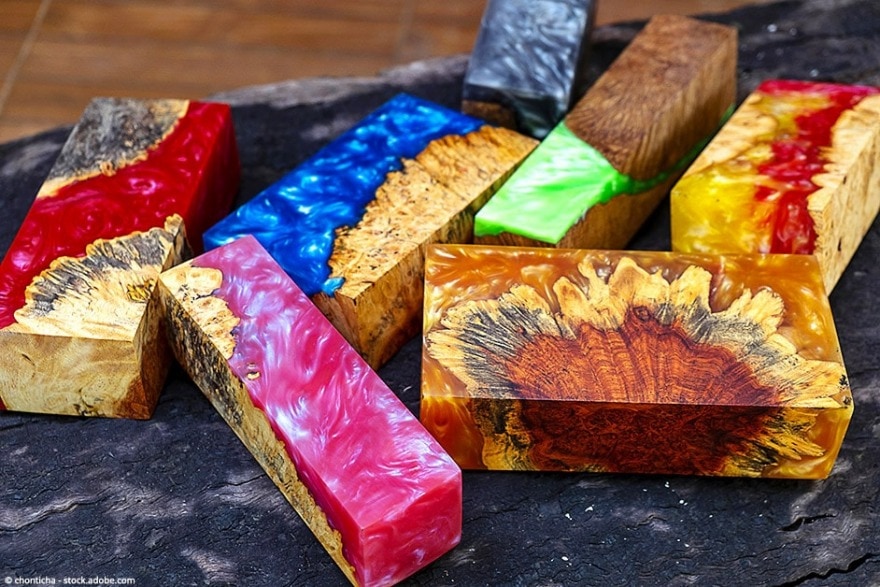
Coloring Resin to Create Contrast with Wood
Resin can be used when it is transparent, but it can also easily be colored. There is a myriad of possibilities, such as transparent colors, metallic effects, or opaque liquid colors. Normal acrylic paint won’t work as it contains water. The following paints can be mixed with all epoxy resin:
Liquid Paint
- Set contains 18 opaque liquid colorants for epoxy resin
- Non-toxic and odorless in transparent 0.35 ounce bottles
- Concentrated and easy to use for achieving solid colors in resin
- This is the ResinTint complete set with all basic colors
- Also included: metallic & neon set contains 8 shimmering colors
- High-quality coloring agents for epoxy resin
- Set contains 16 vibrant and translucent liquid pigments
- Odorless, vegan-safe, and easy to use
- Concentrated and blends easily for creating translucent colored resin
- The airbrush colors from Jacquard are well proven for mixing with resin
- They are highly pigmented, very brilliant and lightfast
- With this set you have can add shimmering accents to your pourings
Color Pigments and Powders
- Hemway has one of the largest ranges of pigment powder dyes
- You can simply mix this slowly into resin until the desired ratio is reached
- Colorfast and lightfast, so your works will still shine brilliantly even after a long time
- High-quality, non-toxic, metallic color, mica pigment powders
- Includes 8 colors in 5 ounce jars
- Suitable for multiple art-forms including resin art
Sanding after Curing
To be on the safe side, we recommend waiting a week before sanding and polishing the resin surface. Seemingly cured resin can be soft under the surface and won’t leave you with a nice finish.
Depending on the size of the object or the surface, you can use sandpaper with a fine grain for small objects. This sandpaper has been useful for this and can be used for dry or wet sanding. You should always sand from coarse to fine grain so that there are no visible traces of sanding.
For larger surfaces like River tables, floors, countertops, etc., you should use an orbital sander for the best results. The orbital sander not only rotates but gives you much finer sanding. Additionally, sanding is done in a fraction of the time and it is much less likely to sand unevenly in some places.
The last Step – Polishing, Oiling, and Finishing your Artwork
Epoxy resin does not necessarily require surface treatment. However, depending on the application, the wood next to it is raw and untreated. Also, fine stress marks in the epoxy resin may still be present and the depth effect is less-than-optimal. In that case, the following procedures can be utilized:
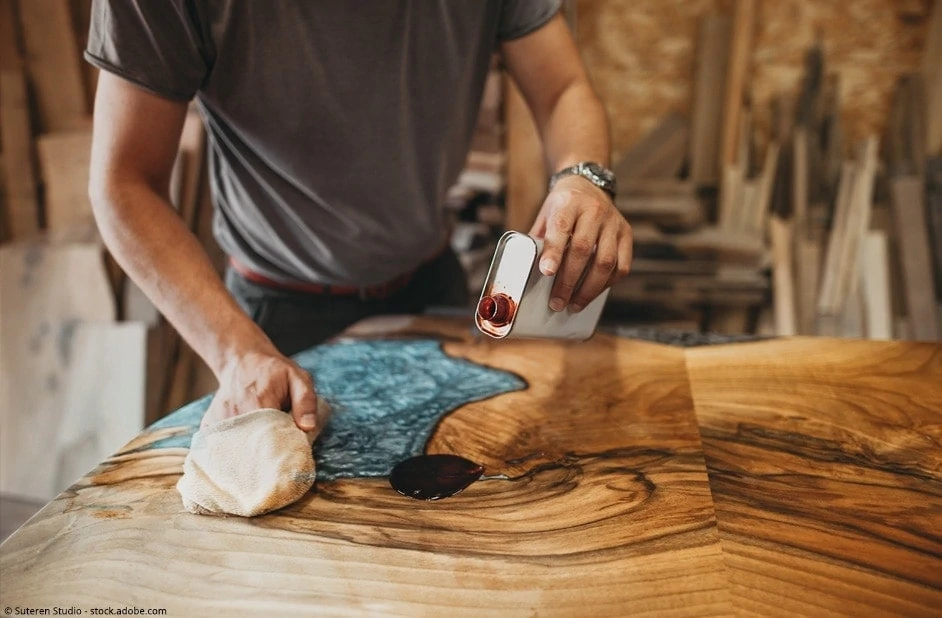
- Take a fine polishing paste on a rag and rub in a circular motion over the epoxy resin. You will polish the surface and eliminate any grind marks present on the surface of the resin. Be careful that the paste is not spread onto the wood, otherwise the pores of the wood will get clogged. For larger surfaces, an orbital buffer/polisher is recommended.
- Wipe the polishing paste away carefully, making sure there is no residue. The surface should now shine beautifully.
- If you are still not satisfied, repeat the first steps.
- Now the wood needs a final treatment. Resin epoxy can also withstand a finish. Use a high-quality wood oil, apply generously with a rag, let it absorb for a few minutes, then wipe dry. You can also use a lacquer. Additional steps are then needed for further polishing at the end.
Application 4: Repairing Wood with Epoxy Resin
Before starting to work on anything, you need to first identify what is the underlying problem, the reason for it. If you are not able to figure it out on your own, then get help. The problem will always differ, and so will its solution.
For instance, the wood is rotting due to moisture that is emitted through another part of the object. In this case, you would have to change the rotten part for something more resistant to moisture like redwood. Apart from this, it would also be good if a sheet of metal can be kept in between them to avoid any kind of contact.
Now, this is a great way to control problems, which led to the first outcome. Another kind of problem that may arise is that the paint on the wood gets old and ineffective, then the wood absorbs water and rots. This can be easily repaired by applying another coat of paint.

Now, in these situations, the repair can be easily conducted by introducing new materials to the environment and eliminating the reason for the specific problems. But in cases where the causes are much more complicated, this can become a tough task to undertake. This is when epoxy resin can come to the rescue.
The only caution that you will have to take with epoxy is that you will have to let the wood dry completely, which can take longer than you expect. If this is not done, then the wood can rot further due to the moisture trapped. As such, epoxy resin and wood will not bond properly.
Now that you have an idea about how to start, let’s learn step-by-step, the process of repairing wood with epoxy resin.
Step 1: Take Out or Save the Damaged Parts
Using a screwdriver, try to determine the extent of damage by poking the parts which are rotten or have started to putrefy. Now, these parts should be either systematically removed or should be secured with an epoxy consolidant.
For removing all the required parts, you would require a paint scraper, a screwdriver, and a chisel. Once you are sure how much is damaged, kick off the process by taking off the upper layer of paint along with the rotten parts of the wood. There is a possibility that if the paint is old, it also contains lead which can be toxic. For this, you must read about removal techniques to keep it safe.

If the part has some hope in terms of being rescued and has dried out sufficiently, then drill ¼ inch holes, each 1 inch apart, and let the epoxy consolidant work its magic. It should soak into the rotten piece of wood. If the surface is vertical, then it would be better to have deeper holes, so that the consolidant gets maximum space inside and moisture will also get space to exit letting the epoxy to soak.
If, by mistake, you drill right through the wood, you can use putty or clay to secure the bottom to stop the epoxy consolidant from leaking. For understanding how to use the consolidant better while wood repairing with epoxy resin, read the instructions provided in the next step.
Step 2: Use a Liquid Epoxy Consolidant
Choose a ventilated area to work or prepare yourself with a respirator to counter the fumes. How to use the consolidant to a large extent depends on the instructions provided by the manufacturer. Read them at least twice as proportions can get tricky with epoxy resin, and they have to be exact in case of wood epoxy in particular.

Once the mixture is prepared, squeeze it into the holes that have been drilled on the wood for the required repair. A small brush can help to apply the consolidant with ease. Continue doing so until the entire piece is saturated and has absorbed the liquid throughout.
It is important to let the wood dry after this, at least for a week. That is why keeping it protected under a plastic sheet, so that it is protected from dust and rain, is a good idea. To speed up the process, you can place the sheet outside during the sunny hours of the day.
Step 3: Prepare the Filler for the External Surface
Even if the consolidant has not solidified completely, you can move forward to this part. This can be a little tricky to understand, so read carefully.
To start with, scoop the two parts (A and B) of the epoxy filler equal to the size of a golf ball using a wooden stick. Using a putty knife, mix them for some time until they are thoroughly mixed. Label the lids of the two parts so that the lids are not mixed up and permanently glued to the wrong containers. The same can be done for the sticks so that distracting mishaps can be avoided.
Also, make sure that the objects that you are using for mixing are clean for the same reason. If the new epoxy is mixed with the remains of hardened resin, it will react and reduce your time of work.
The temperature will matter a lot after this point, as it will decide when the hardening of the resin filler starts. At around 21°C, you will have 30 minutes to work with it. The warmer it is, the faster the epoxy will harden. If the temperature is colder, the epoxy will take more time to harden. That is why it is recommended that the work is conducted in the shade so that all the materials are cool when they are mixed before they are applied. But when it is done, the piece can be kept in the sunlight to warm the wood epoxy for faster curing.
Step 4: Fill the Cavities with Epoxy Filler
Using the putty knife, squeeze the filler into the areas which need to be repaired. Make sure that you use a bit of force so that the epoxy resin and the wood are bonded.
To make sure that the filler is used optimally when you are filling deeper areas, you can carve parts of another piece of wood and fix these blocks after the application is completed. Over them, you can put additional paste for better results. Make sure that the pieces you use are of the same type of material, and the grains are aligned when you fix them.
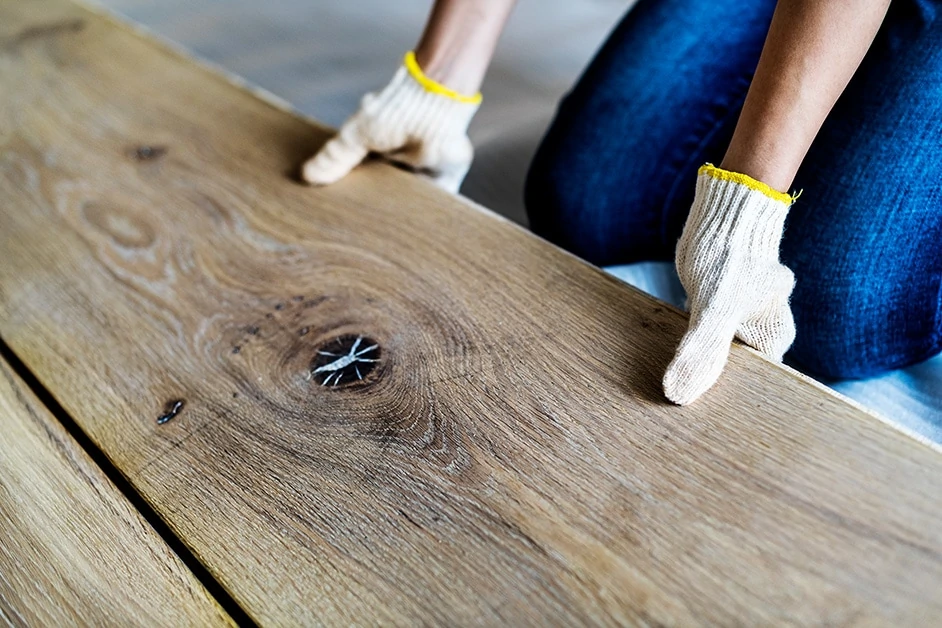
Step 5: Shape the Filler into the Desired Shape
Wearing gloves, use your fingers to get the desired shape. Overfilling the voids can make it easier to shape. What is also to be considered is that the shape does not have to be perfect and must be adhered to the surrounding materials. Let the patches harden as per the weather.
Step 6: Modify the Shape
Check the hardness of the epoxy, and if it doesn’t dent, that means it can be filed using sandpaper and other tools. First, work up a rough contour using a Surform plane or a rasp. The best guide to follow is the natural shape of the surrounding wood.
After you nail the basics, use sandpaper to add the detail. This will help you to work on the surface where needed. For better results, fold the sandpaper around a stick or a cylindrical body, so you can sand more accurately, and you don’t accidentally sand areas you don’t want to. This step has to be undertaken with great patience and precision. Don’t rush and make sure that only the areas you wish to work on are affected.

If more epoxy is removed, you can always go for a second layer application. Before doing so, make sure that the first layer is dusted, and the filler is precisely mixed. If you wish to have a thinner layer, you can mix some consolidant and then add filler to get the right consistency. Heat the new layer using a dryer, and then you can continue with sanding again. If you then paint a proper layer over the epoxy, it can last for a very very long time.
After you have sanded first with 80 grit sandpaper, use 120 grit sandpaper to refine your work. While sanding, your eyes must be protected, so don’t forget to wear a pair of eye goggles and a mask for your nose and mouth. Clean the dust using a vacuum and acetone.
Step 7: Paint for Protection
Start with a primer and then add two coats of acrylic paint to secure the epoxy resin and wood. Use a polyurethane caulk to finish the final layers. Make sure that the repaired areas are checked every year for repainting or re-caulking.
Wood repairing with resin epoxy can be easily done with the above process. Make sure all the precautions are taken, as mentioned, and read about the materials you use beforehand for better clarity.
Processing Challenges – Tips and Tricks
Working with epoxy resin casting has its pitfalls. We have listed the biggest issues for you and will tell you how to avoid or resolve these issues
Does Epoxy Resin bind to Wood?
Yes, epoxy resin generally sticks to nearly all surfaces. The thinner the resin, the more likely it is to penetrate the pores of the wood and bind to it. Resin with a thick viscosity builds a layer on top instead.
The Epoxy Resin shrinks too much
Resin, especially cheap resin, will shrink during the curing process and can lead to fractures or detachments in the surface. Here is a tip: test how the resin will react on a scrap piece of wood, and if needed, purchase a higher-quality product.
The Epoxy Resin sinks into the Wood
For any porous surfaces such as wood, it is particularly important to seal the surface first. You do not need a separate product for this, rather you can simply apply a thin layer of resin to the wood and let it cure. Then you have perfectly prepared the wood for the final surface treatment.
Several Bubbles in Cast Resin
Air bubbles occur when the two resin components are thoroughly mixed. This can’t really be prevented, but typically they can be removed from the material without a problem: After the casting process you can apply a torch or hot air gun over the surface in quick motions and the bubbles will rise and disappear. For stubborn bubbles, you can also use a toothpick to break the bubbles. Hair and dust can also be removed this way. The surface must be still liquid and able to level itself back out, however.
Tip: Don’t apply the heat to one spot for too long otherwise the resin will discolor and liquify again. This can lead to unattractive patches.
The optimal Working Temperature
Ideally, you should work with the material at around 20 degrees Celsius/68 degrees Fahrenheit and with as little humidity as possible. This will give you the best results and reduce the loss of quality. Until the curing is complete, ambient temperatures should remain constant to prevent cracking or unevenness. It is recommended that you read the specifications from the respective manufacturers as they differ from system to system.
The Resin is extremely hot during Casting
Depending on the resin used, the appropriate thickness of each layer is approx. 1cm-2cm (1/3in-3/4in). The resin can start to boil if you cast the layers too thick. For this reason, you should try to pour thin layers and wait until they have hardened, then you can pour the next layer, and so on. This will give you the desired thickness of the surface.
The Epoxy Resin cures too quickly
The different resins have different curing times. Additionally, the general rule of thumb is the greater the mixture quantity, the faster it cures. It may then be beneficial to split up the mixture to prevent it from curing prematurely.
Resin appears cloudy after Curing
This could be because of three possibilities:
- The epoxy resin is too old and has exceeded its shelf life.
- You did not follow the exact mixing ratio.
- You are using a low-grade resin.

Preventing Yellowing
For transparent or crystal-clear epoxy resin to retain its brilliance and transparency, you must purchase a special resin that protects against yellowing. For colored resin, this is not necessary.
Storing Epoxy Resin
Epoxy resin that has not yet been mixed has a relatively short shelf life of around 12 months from production. Therefore upon purchasing, it is important to pay attention to these dates and use the material within this timeframe. To avoid loss of quality while storing the product, keep it between 10-30 degrees Celsius (50-86 degrees Fahrenheit).
Is the Cured Epoxy Food Safe?
In its cured state, epoxy resin is chemically neutral and fundamentally suitable for contact with food. It is no coincidence that this material is also used for prosthetics, aquarium decorations, food tanks, coating for kitchen worktops, and much more. However, we recommend that you read the following carefully. This may vary from manufacturer and system. There is a certification that approves use with food, but it is expensive, and very few manufacturers use it.
Calculating the required Quantity of Epoxy Resin – the Epoxy Calculator from acrylgiessen
Resin is relatively expensive and mixed resin must be used quickly, which is all the more reason to mix the appropriate quantity. At acrylgiessen.com, we have created an Epoxy Resin Calculator for this purpose to calculate the required amount of resin for the desired area.
Health Advice for Working with Resin
Even if this is not explicitly stated by the resin manufacturer, you should use the product in a well-ventilated room. It is also recommended that you wear a respirator with the appropriate filter, and use nitrile gloves so that you don’t come into contact with potential allergens.
- Half-mask multi-purpose respirator
- Patented nose-bridge design for optimum fit and seal
- lightweight design with long-life cartridges and hygiene cover
- Resin should of course not get in your eyes
- Therefore you should wear safety glasses when working with epoxy resin to protect yourself
More interesting Blogposts about Epoxy Resin
Looking for tutorials on resin / epoxy resin techniques?
- Best Epoxy Resin – Find the perfect Epoxy Resin for all your projects
- Resin Epoxy Art – Basics for your first Steps in Resin Art
- Beach Art – Tutorial for Resin Art with Textures
- Resin Geode Art DIY – Casting your first Geodes yourself
- Resin Epoxy Calculator – Simply Calculate the Amount of Resin you Need
Main image: © chonticha – stock.adobe.com
In 2005, Charlene completed her wellness degrees in therapeutic aromatherapy and reflexology at the International School of Reflexology and Meridian Therapy. She worked for a company offering corporate wellness programs for several years before opening her own therapy practice. In 2015, she was asked by a digital marketer friend to join her company as a content creator, and it was here that she discovered her enthusiasm for writing. Since entering the world of content creation, she has gained a lot of experience over the years writing about various topics such as beauty, health, wellness, travel, crafting, and much more. Due to various circumstances, she had to give up her therapy practice and now works as a freelance writer. Since she is a very creative person and as a balance to writing likes to be active in various areas of art and crafts, the activity at acrylgiessen.com is perfect for her to contribute their knowledge and experience in various creative topics.
Learn more about Charlene Lewis and about us.


















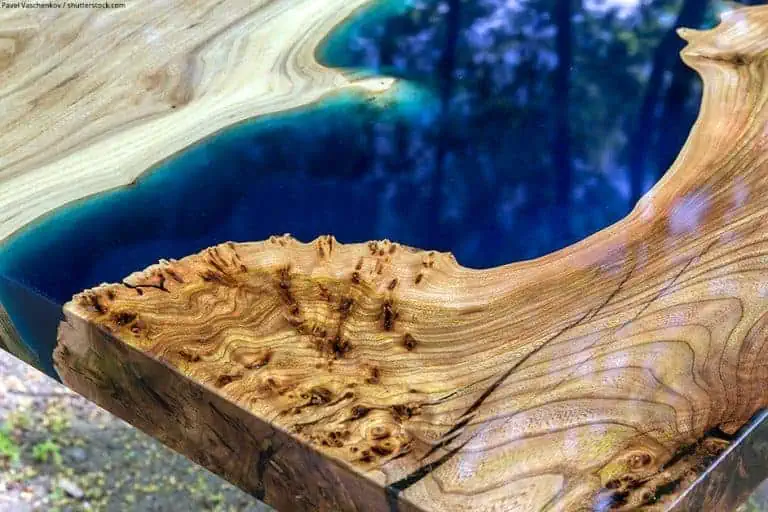
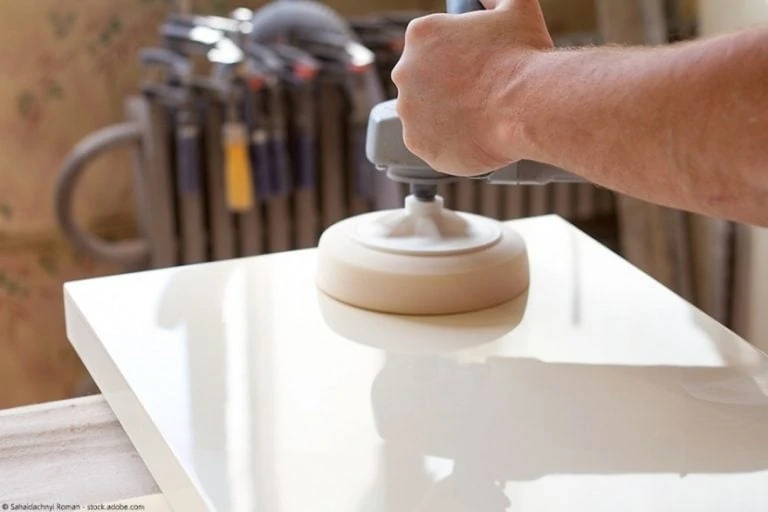

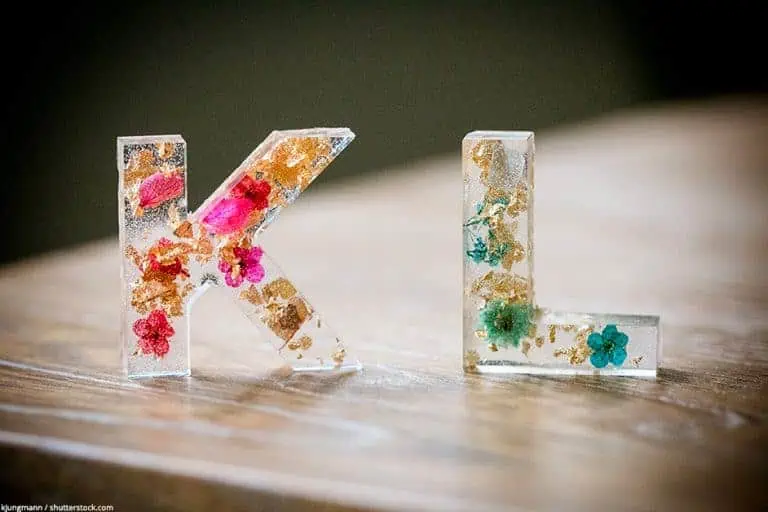

Great and helpful article, keep up the good work!